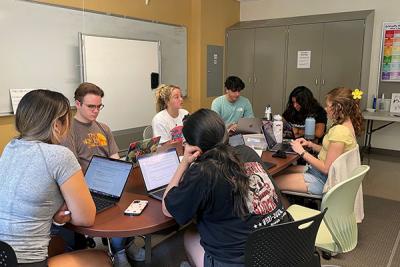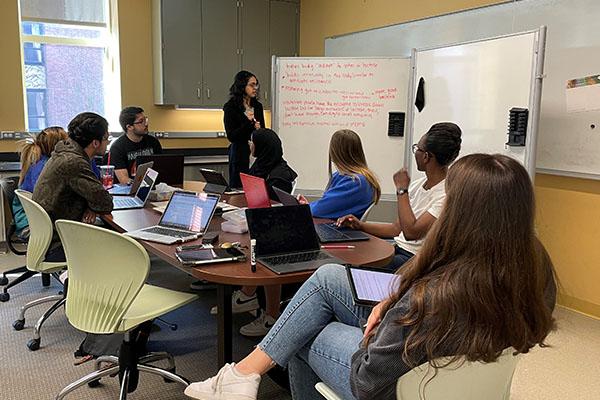Ohio State is in the process of revising websites and program materials to accurately reflect compliance with the law. While this work occurs, language referencing protected class status or other activities prohibited by Ohio Senate Bill 1 may still appear in some places. However, all programs and activities are being administered in compliance with federal and state law.
Biology PLTL Course Coordinator || What is PLTL? || What to expect during a PLTL workshop || Expected Workload || Why Take Biology 1113 or 1114 with PLTL || What is Biology 1111 and 1112? || Evidence that PLTL Improves Student Learning || Additional Information & Resources about PLTL
Biology PLTL Course Coordinator:

Dr. Erin O’Brien (obrien.501@osu.edu)
Office: Jennings 255D
Pronouns: she/her/hers
What is PLTL?
Peer-Led Team Learning (PLTL) is a mode of learning that complements the more familiar traditional biology classroom formats: lecture, lab, and recitation. We call each PLTL session a “workshop.” PLTL workshops enhance biology students’ already high-quality educational experience by providing a space in which they can spend more time actively engaging in discussion and debate, asking questions, and working together to answer open-ended problems that model real-world applications of the key biology concepts they’re learning in lecture and lab.
The Center for Life Sciences Education (CLSE) currently offers four Biology courses with PLTL, Biology 111, 112, 1113.02 and 1114.02. See How to enroll in Biology courses with PLTL for more information.
Students who take Biology 1113/1114 with PLTL report many benefits including:
- More time to ask questions and talk to peers
- Enjoyment of authentic, real-world applications of biology concepts
- Increased confidence in their understanding of biology concepts
- Increased confidence in their exam-taking skills
- Strengthened scientific and metacognitive reasoning skills
- Development of successful learning strategies
Research conducted on PLTL programs (including our own research conducted by the CLSE) show many benefits of PLTL including:
- Higher exam grades and final course grades
- Improved performance in subsequent upper division biological science courses (e.g., BIOLOGY 3401, MOLGEN 4500, BIOCHEM 4511)
- Reduced likelihood of dropping/switching out of a STEM major
For more information on the results of studies conducted by the CLSE, go to Evidence that PLTL Improves Student Learning
What to expect during a PLTL workshop
The PLTL model we use integrates multiple learning styles and strategies, which help to create a more comfortable social environment to discuss biology and allow students to develop their understanding of scientific concepts in terms and language that are more accessible to them.
PLTL workshops are intended to be more casual and informal than a lecture, recitation, or laboratory setting. Each PLTL workshop group is comprised of 4-10 students. The small group size makes it possible for each student to speak up and participate, and it makes it easier for the group to get to know each other and form a supportive learning community.
During each PLTL workshop, students work together to solve biology related questions from the workshop packet. These packets have been purposefully designed to support and supplement what students are learning in the lecture and lab components of Biology 111/112/1113/1114. The problems are complex, challenging, open-ended, and allow for multiple plausible answers (hypotheses). As such, there are no answer keys!
The group’s work is facilitated by a fellow undergraduate student, called a peer leader. A peer leader is a student who previously excelled in one or more of the introductory biology courses and has been rigorously trained to facilitate PLTL workshops by moderating discussions and debates and asking insightful questions to guide and inspire the students. A peer leader’s role is that of a mentor: as successful students themselves, peer leaders share valuable strategies for learning biology and succeeding in the course, tips for navigating campus life and taking advantage of academic resources, and much more. Peer leaders do not provide formal instruction: they do not teach or explain biology concepts, and they do not tell the group if their proposed solutions to workshop problems are “right” or “wrong.” Instead, they help students practice the metacognitive and scientific thinking strategies necessary to self-evaluate their work and measure their learning achievements.


Comments from previous PLTL students:
What did I like MOST about PLTL?:
- As a PLTL student I really enjoyed the relationships I built in my workshop group.
- It was a fun part of my day to catch up with my fellow classmates and work on the biology workshop together.
- I enjoyed how PLTL wasn't like a traditional learning environment with a central teacher, but it allowed me the freedom to make my own mistakes, have peers share their stances, and ultimately, help me reformulate my own opinions.
- Trying a new way of learning. This course allows students to challenge themselves and improve their understanding of the course curricula
- My favorite part about being a PLTL student was being respected and welcome at the same time. It's difficult to be uncertain and vocal about it, and I think PLTL did an excellent job of supporting me.
What did I like LEAST about PLTL?:
- Some questions would be asked numerous times, and although I know it was for the sake of emphasis, it felt redundant sometimes. With the recent shortening of the packets and the removal of the weekly content connections, I think PLTL has improved a lot.
Comments about being a Peer Leader for PLTL:
Why did you want to become a peer leader for PLTL?:
- I had such a positive experience as a PLTL student in that it helped me appreciate the application of biological concepts we learned in class to real-life examples.
- As a peer leader, I can help other students achieve a similar appreciation. Also, being a PLTL leader has helped me learn new facilitation techniques that I'm sure I'd use outside of class.

Expected Workload
In addition to the weekly workshop session, students in PLTL will have two assignments: one to help them prepare for the upcoming workshop (Pre-workshop) and one to reflect on their past workshop (Post-workshop). During some weeks, students will also be asked to make connections with the course components (PLTL, lecture, lab, and recitation) and among current and past concepts. Students should expect to spend the following time on PLTL related activities each week:
- Pre-workshop Prep Assignment (~20-30 min)
- Workshop (80 - 110 min)
- Biology 1111/1112 workshops are 80 minutes and Biology 1113.02/1114.02 are 110 minutes
- Post-workshop Reflection Assignment (~30-45 min)
Why Take Biology 1113 or 1114 with PLTL
Biology 1113.02 and Biology 1114.02 are the 5-credit versions of Biology 1113.01 and 1114.01 courses (both are 4 credits). The extra 1 credit hour accounts for the extra time students will spend in PLTL workshops and on the PLTL assignments each week. Attendance and participation in PLTL workshops are required and closely monitored by the peer leaders and PLTL coordinator.
Biology 1113.02 and 1114.02 have the same requirements and learning outcomes as Biology 1113.01 and 1114.01 courses, respectively. Currently, Biology 1113.02 and 1114.02 are smaller sections of Biology 1113 and 1114 with less than 100 students per section as compared to 200 – 600 students in the non-PLTL course offerings. In general, lecture instructors tend to get to know their students better in smaller sections and, as a result, students tend to feel more comfortable interacting with their instructors. If you prefer taking courses with less than 100 students, then the PLTL versions of Biology 1113 and 1114 may be a great fit for you!!
Since the PLTL sections are smaller, the courses can fill up quickly. If you wish to join the waitlist for a full section, you will need the help of your academic advisor or the Biology PLTL Course Coordinator Dr. Erin O’Brien (obrien.501@osu.edu).
What is Biology 1111 and 1112?
Starting Autumn 2025, the CLSE began offering a two semester introductory biology courses, Biology 1111 and 1112, which together fulfill the same requirements as Biology 1113x. Both courses were designed to have PLTL as an added learning component. Currently, Biology 1111 is only offered during autumn terms and Biology 1112 in the spring.
Learn more about Biology 1111 and 1112:
Evidence that PLTL Improves Student Learning
PLTL and its associated components have been shown to not only help students improve their performance in STEM courses, but also to build skills such as metacognition, self-regulated learning, critical thinking, and comradery. These additional skills help students to feel empowered, included, supported, and a sense of belonging, which helps them to go on the achieve academic success, such as graduating with a STEM degree (Dweck 2006 ebook; Schmidt et al. 2009; Preszler 2009; Haak et al. 2011; Kowalczyk 2011; Kapur and Bielaczyc 2012; Kudish et al. 2016; Snyder et al. 2016; Broda et al. 2018).
If you are interested in taking one of our PLTL courses or have more questions, please contact Dr. O’Brien (obrien.501@osu.edu) and she will be happy to answer any of your questions.
Additional Information & Resources about PLTL
You can read more about PTL that was published by the PLTL International Society:
- PLTL Learning Theory: https://pltlis.org/learning-theory/
- History of PLTL: https://pltlis.org/wp-content/uploads/Dreyfuss-History-of-PLTL-2012.pdf
- The Six Critical Components of PLTL: https://pltlis.org/wp-content/uploads/site_files/The_Six_Critical_Components.pdf
Citations
Broda, Yun, Schneider, Yeager, Walton, and Diemer. 2018. Reducing inequality in academic success for incoming college students: a randomized trial of growth mindset and belonging interventions. J Res Educ Eff 11:317-338.
Dweck. 2006. Mindset: The new psychology of success. Random House.
Haak, HilleRisLambers, Pitre, and Freeman. 2011. Increased structure and active learning reduce the achievement gap in introductory biology. Science 332: 1213-1216.
Kapur and Bielaczyc. 2012. Designing for productive failure. J Learn Sci 21:45-83.
Kowalczyk. 2011. Review of teaching methods and critical thinking skills. Radiol Technol 83: 120-132.
Kudish, Shores, McClung, Smulyan, Vallen, and Siwicki. 2016. Active learning outside the classroom: Implementation and outcomes of peer-led team-learning workshops in introductory biology. CBE Life Sciences Education 15: ar31.
Preszler. 2009. Replacing lecture with peer-led workshops improves student learning. CBE Life Sciences Education 8: 182-192
Schmidt, Van Der Molen, Te Winkel, and Wijnen. 2009. Constructivist, problem-based learning does work: A meta-analysis of curricular comparisons involving a single medical school. Educ Psychol 44: 227-249.
Snyder, Sloane, Dunk, and Wiles. 2016. Peer-led team learning helps minority students succeed. PLOS Biology 14(3): e1002398. https://www.ncbi.nlm.nih.gov/pmc/articles/PMC4784972/
